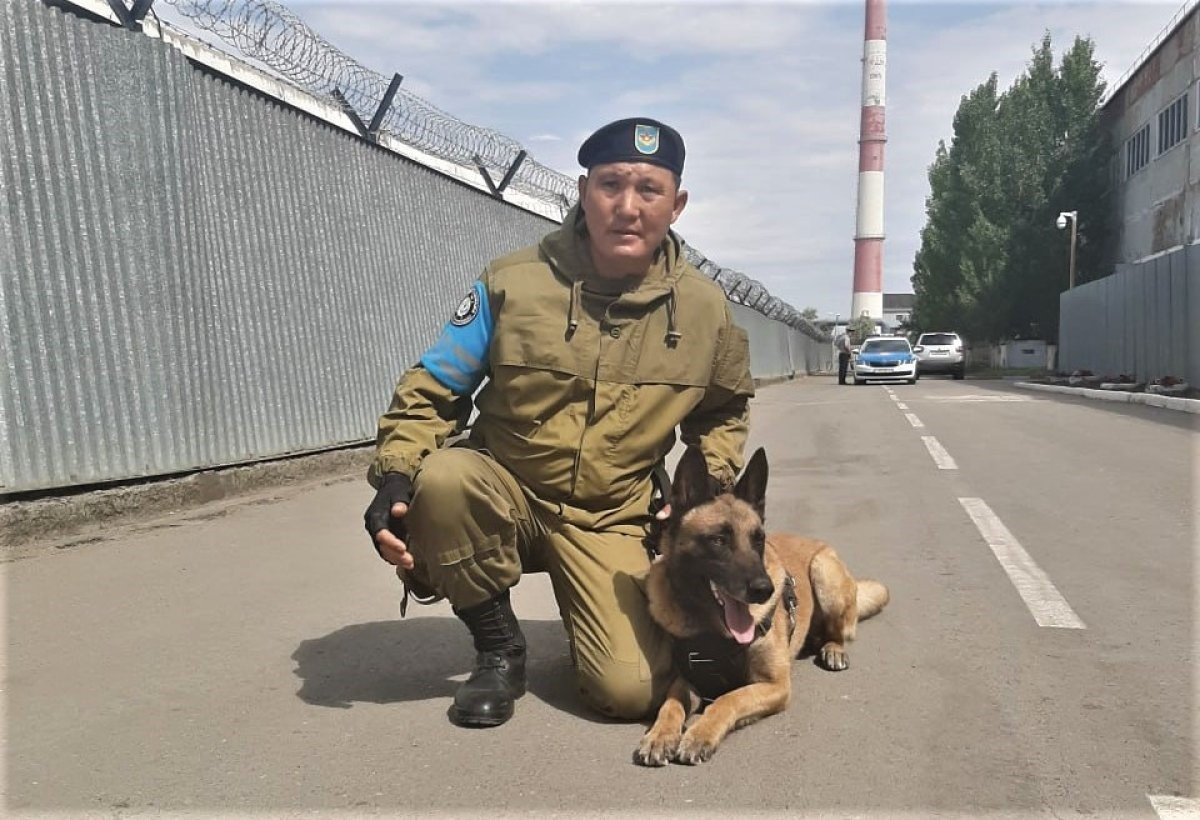An exclusive material on training dogs for service in law enforcement agencies.

The nuances of working with dogs were shared by the canine specialists of the Military Police Department in the Akmola Garrison, Major Nurzhan Naizakul and Sergeant Baurzhan Kaylinov, with Sarbaz.kz.
In the modern world, where security and law enforcement agencies face various threats, it becomes important to have reliable and loyal allies. Unfortunately, conscripts do not possess a good "nose and fangs," which is why one of the most dedicated and effective companions in ensuring security has been the canine services.
The military personnel greeted us on the parade ground with an adorable ginger dog. As it turned out, the Belgian Shepherd's name was Boni, and she has been serving in the police for over 5 years.
Sergeant Baurzhan Kaylinov shared his 23 years of experience as a canine handler. After completing a three-month course, he started working with dogs and has trained around 28 dogs for the law enforcement agencies, not counting his own pets. He has also received advanced training in Germany and Almaty.
The most common breeds to "serve" in the military, are German and Belgian Shepherds, usually due to their rapid trainability. To train puppies from 3 to 7 months old, they are typically purchased from private breeders through state procurement portals. After a month of quarantine, they begin general obedience training. By the way, dogs "serve" in the army for 8 years and 3 months before retiring to private shelters, where anyone can adopt them. Dog training begins with basic commands.
Like true psychologists, canine specialists work with puppies. A specialist determines the dog's psychotype - whether it is active or passive and whether it has leadership qualities or not. If the dog is overly active, it is trained at a slower pace, and vice versa. A dog with leadership qualities will always challenge the owner's authority, so it is necessary to speak to it in a more commanding voice.
While the military serviceman was talking about the nuances of dog psychology, Boni kept fidgeting by his side.
"Boni is a vivid example of a dog with leadership qualities. She always tries to prove that she is the leader of the pack, and the most challenging task for a canine handler is to prove otherwise," – the specialist notes.
An integral part of training is not only rewarding with food but also using a favorite toy. For this purpose, various toys are spread out in front of the puppy - from regular balls to soft toys. The puppy chooses what it will spend the rest of its service with from such a wide assortment.
"The main nuance of dog training is that the 'subordinate' should not hold a grudge against the owner. Otherwise, the dog may let you down at a critical moment. For a dog, the owner is the best friend and support. Many people still believe that training drug-sniffing dogs involves exposing them to substances. But this is a common misconception. The process of training these four-legged creatures is quite lengthy and takes place strictly in a playful manner," –the military serviceman emphasises.
To develop the "search" command, canine handlers take the puppy's favorite toy and hide it while playing with it. The puppy always finds its toy - its saliva and scent remain on it. With each play session, the task becomes more complex, and the dog becomes accustomed to the "search" command. Later, after the command has been established, specialised training begins, involving searching for narcotics or explosives. Each canine service has samples of explosive odors and specially developed scents representing seven types of narcotics at its disposal. These scent samples are placed in a container at the center of the training ground, and the dog is released to roam. Given the puppy's innate curiosity, its initial instinct is to investigate the source of the odor. Once the dog identifies the scent source, the handler employs a clicker and rewards the animal with its favorite toy. By consistently reinforcing this action, a chain is established: if the dog detects the odor, it receives a reward.
As explained by a military canine handler, the process of scent detection for dogs is complex. For instance, explosive substances are relatively heavy and tend to settle on the ground, dispersed by the wind. When the scent is detected, the canine follows it in pursuit of the highest concentration. Upon locating the source, the dog either sits or freezes. Recalling the experiences of servicemen, if the dog is ignored for a prolonged period, it will naturally turn with a pleading gaze as if to say, "Come on, reward me," because the dog seeks not the approval of its handler but rather the toy or food reward. To provide additional confirmation, the command "show" is utilised. In response, the dog intensifies its scenting behavior, indicating a more precise location of the target object. If uncertain, the dog will continue searching for the scent elsewhere.
Furthermore, physical conditioning is an integral aspect of training these animals. In addition to combat commands such as apprehension and frontal attack, it is crucial for dogs to develop their respiratory system. Since the lungs play an active role in scent detection, an untrained dog immediately after the "search" command is unable to sustain long-distance running.
Currently, there are six dogs serving in the military police force of the Akmolinsk Garrison. They effectively fulfill their duties in upholding law and order. These four-legged companions, aside from their daily training sessions, are utilized in various public events and meetings of high-ranking officials, where they dutifully serve on par with other military personnel.